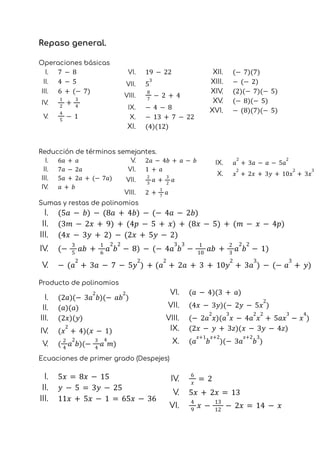
Repaso general. Algebra. (1).pdf
- 1. Repaso general. Operaciones básicas I. 7 − 8 II. 4 − 5 III. 6 + (− 7) IV. 1 2 + 3 4 V. 4 5 − 1 VI. 19 − 22 VII. 5 3 VIII. 8 7 − 2 + 4 IX. − 4 − 8 X. − 13 + 7 − 22 XI. (4)(12) XII. (− 7)(7) XIII. − (− 2) XIV. (2)(− 7)(− 5) XV. (− 8)(− 5) XVI. − (8)(7)(− 5) Reducción de términos semejantes. I. 6𝑎 + 𝑎 II. 7𝑎 − 2𝑎 III. 5𝑎 + 2𝑎 + (− 7𝑎) IV. 𝑎 + 𝑏 V. 2𝑎 − 4𝑏 + 𝑎 − 𝑏 VI. 1 + 𝑎 VII. 2 3 𝑎 + 3 2 𝑎 VIII. 2 + 1 7 𝑎 IX. 𝑎 2 + 3𝑎 − 𝑎 − 5𝑎 2 X. 𝑥 2 + 2𝑥 + 3𝑦 + 10𝑥 2 + 3𝑥 3 Sumas y restas de polinomios I. (5𝑎 − 𝑏) − (8𝑎 + 4𝑏) − (− 4𝑎 − 2𝑏) II. (3𝑚 − 2𝑥 + 9) + (4𝑝 − 5 + 𝑥) + (8𝑥 − 5) + (𝑚 − 𝑥 − 4𝑝) III. (4𝑥 − 3𝑦 + 2) − (2𝑥 + 5𝑦 − 2) IV. (− 3 5 𝑎𝑏 + 1 6 𝑎 2 𝑏 2 − 8) − (− 4𝑎 3 𝑏 3 − 1 10 𝑎𝑏 + 2 3 𝑎 2 𝑏 2 − 1) V. − (𝑎 2 + 3𝑎 − 7 − 5𝑦 2 ) + (𝑎 2 + 2𝑎 + 3 + 10𝑦 2 + 3𝑎 3 ) − (− 𝑎 3 + 𝑦) Producto de polinomios I. (2𝑎)(− 3𝑎 2 𝑏)(− 𝑎𝑏 2 ) II. (𝑎)(𝑎) III. (2𝑥)(𝑦) IV. (𝑥 2 + 4)(𝑥 − 1) V. ( 2 4 𝑎 2 𝑏)(− 3 4 𝑎 4 𝑚) VI. (𝑎 − 4)(3 + 𝑎) VII. (4𝑥 − 3𝑦)(− 2𝑦 − 5𝑥 2 ) VIII. (− 2𝑎 2 𝑥)(𝑎 3 𝑥 − 4𝑎 2 𝑥 2 + 5𝑎𝑥 3 − 𝑥 4 ) IX. (2𝑥 − 𝑦 + 3𝑧)(𝑥 − 3𝑦 − 4𝑧) X. (𝑎 𝑥+1 𝑏 𝑥+2 )(− 3𝑎 𝑥+2 𝑏 3 ) Ecuaciones de primer grado (Despejes) I. 5𝑥 = 8𝑥 − 15 II. 𝑦 − 5 = 3𝑦 − 25 III. 11𝑥 + 5𝑥 − 1 = 65𝑥 − 36 IV. 6 𝑥 = 2 V. 5𝑥 + 2𝑥 = 13 VI. 4 9 𝑥 − 13 12 − 2𝑥 = 14 − 𝑥
- 2. VII. 2 3𝑥 + 4𝑥 = 8 VIII. 𝑥 = 2 IX. 18𝑥 + 6 + (2 − 2𝑥) =− (− 15𝑥) + X. Desigualdades (Inecuaciones). I. 2𝑥 − 3 > 𝑥 + 5 II. 7 − 𝑥 2 > 5𝑥 3 − 6 III. 3𝑥 + 4 < 16 IV. − 6 − 𝑥 >− 8 V. 5𝑥 − 10 > 3𝑥 − 2 VI. 3(𝑥 + 5) ≥ 𝑥 − 3 VII. 3(2𝑥 − 1) > 4 + 5(𝑥 − 1) Intervalos. Escribe en notación de intervalo al conjunto mostrado. Ejemplo: R. (8,12] 12 ≥ 𝑥 > 8 I. 3 > 𝑥 ≥ 2 II. 9 ≤ 𝑥 ≤ 10 III. − 2 > 𝑥 >− 3 IV. − ∞ < 𝑥 <∞ V. − ∞ < 𝑥 ≤ 2 Dominio de funciones. Encuentra el dominio de las siguientes funciones. I. 𝑓(𝑥) = 𝑥 − 1 II. 𝑦 =− 𝑥 2 + 1 III. 𝑦 = 2 + 𝑥 IV. 𝑔(𝑥) = 1 𝑥−4 V. 𝑓(𝑥) = 1 𝑥 2 −4 VI. 𝑝(𝑥) = 𝑥+3 𝑥−2